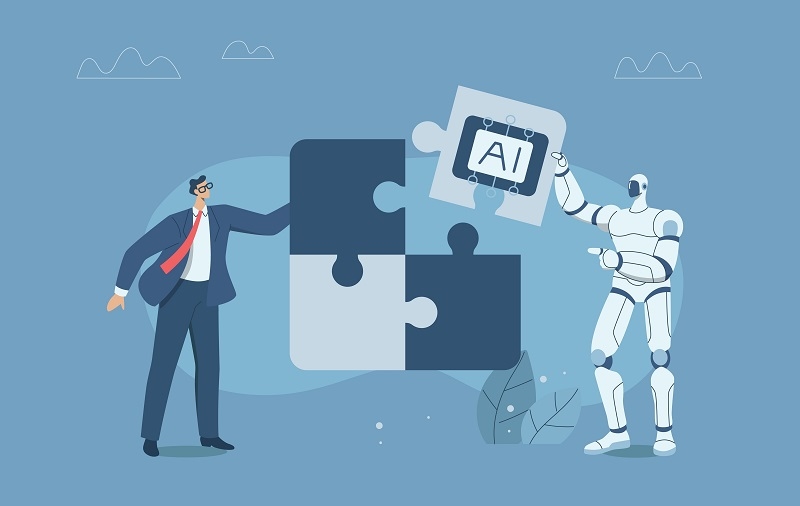
In 2025, generative AI trends are no longer just a headline—they are quietly reshaping the way businesses operate. Workplaces look different. People are not just completing tasks; they are working side by side with machines. AI content creation tools and automation systems have created a world where humans use AI to improve their efficiency.
Day to day work has changed because tasks that once took hours are now done in minutes. Generative AI has been helping people in various ways like content writing and designing. The goal of the best AI tools is not to replace humans, but to make them more efficient.
For example, a writer might start with some rough ideas, but AI can shape them into content. The support from AI feels like having an assistant who is constantly improving your final output.
AI content creation tools have become part of the regular workflow. They are fast, reliable, and consistent. They leave humans to handle the parts that matter most—storytelling, emotion, and connection. Machines can help with facts and patterns, but the spark of creativity is still human.
Some days, AI will generate more than expected, sometimes less, and humans adjust. That little unpredictability is what makes working with AI feel natural. It’s not perfect, and it doesn’t need to be.
AI Automation tools are the quiet backbone of modern work. They do not make noise, but they keep everything flowing smoothly—scheduling, sorting data, sending reminders—all of this can be handled by automation. Humans can focus on thinking and creating instead of repetitive work.
When AI is added, these tools become smarter. They learn from patterns, notice mistakes, and even suggest better ways to do things. It’s like having autopilot in a car. You control the direction, but the heavy work is easier.
Leaders rely on AI to notice things humans might miss. This is because AI can help in identifying elements that can improve the overall operations of the business.

Generative AI has been developing rapidly in 2025. Therefore, it has resulted in the growth of certain AI trends that have helped businesses massively in their everyday operations. You can check the following list to know more about these trends:
AI tools are now embedded in everyday applications. From email drafts to presentation slides, AI is quietly assisting work without people switching apps constantly.
AI has supported different teams to work together and get better results with its real-time suggestions, automatic task prioritization, etc. This has made collaboration faster and smoother for every team member.
Generative AI is learning user preferences. It remembers patterns and adapts suggestions to fit the style, tone, or workflow of individuals.
AI has businesses to predict trends and behaviours more accurately in 2025. Therefore, most companies are now using it to understand customer needs and identify new market opportunities.
Interacting with AI feels closer to talking with a colleague. AI understands context, tone, and intent better, making conversations with it intuitive and useful.
There is a strong focus on responsible AI. Transparency and fairness have become common factors while developing AI tools.
These trends have clearly explained how AI has become a major element for businesses to ensure the smooth running of their daily operations.
The following points will help you understand how Generative AI has helped ventures to improve and optimize their content creation process:
AI content creation allows work that took hours to be done in minutes. Reports, posts, and emails can all be drafted quickly. Teams can meet deadlines without losing quality or creativity.
No matter the platform, AI keeps content consistent. Whether it’s newsletters, campaigns, or internal updates, messaging is clear, professional, and aligned. Teams spend less time revising and more time improving the core ideas.
With routine writing handled by AI, humans have more time to brainstorm, test ideas, and explore new approaches. AI is not taking over; it’s giving people the space to imagine freely. The result is innovation that feels natural, not forced.
AI content creation is also flexible. Some days it produces exactly what’s needed, other days it sparks unexpected inspiration. Humans adapt, refine, and build upon it. That combination creates something unique every time.
Innovation today is about speed, adaptability, and curiosity. Generative AI trends are helping businesses move faster and think differently.
Imagine a design team testing several ideas in an afternoon. Or a research team summarizing hundreds of reports in minutes. Generative AI makes this possible. It allows companies to experiment without huge effort. They can test, fail, and rebuild quickly.
Businesses are exploring new directions with confidence. AI highlights opportunities humans might overlook. Meetings that used to take hours now happen in minutes. Teams see possibilities that were invisible before. Innovation in 2025 is no longer just about competition—it’s about creation, collaboration, and fast learning.
Machines are powerful, but humans bring context, emotion, and empathy. AI can generate words, numbers, or layouts, but it cannot feel the pause, the hesitation, or the subtle inspiration behind a creative decision.
Writers bring emotion. Designers bring connection. Managers bring understanding. These human qualities make AI useful rather than cold. As AI becomes smarter, humans play an even larger role. People shape AI behavior, train it, and guide its learning. That’s where the true partnership begins.
Working with AI is not predictable. Sometimes it overproduces, sometimes it underproduces. Humans adjust, refine, and guide. That inconsistency makes the process feel natural.
Generative AI trends are transforming the way people work, create, and innovate in 2025. They make tasks faster, workflows smoother, and ideas easier to explore. AI content creation and automation tools create space for imagination while handling routine work. The future is not humans versus AI—it’s humans and AI building smarter, better work together.
This content was created by AI